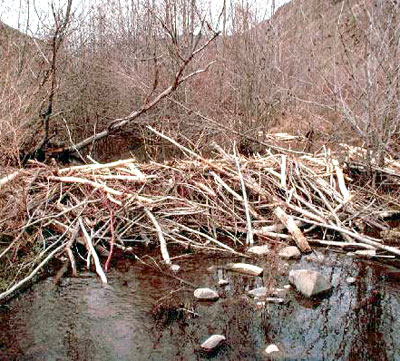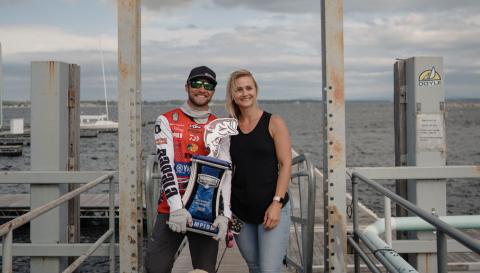Bear Kelly Trades Beavers for Buck Deer
provided by John E. Phillips
In 1996, the late Dick Kirby, creator of Quaker Boy Calls and longtime Mossy Oak enthusiast, started mentoring Bear Kelly as a trapper. Bear primarily bowhunts, but he also hunts with a gun, a muzzleloader and a crossbow. He’s hunted in Montana, Wyoming, Colorado, New York, Ohio and Pennsylvania, as well as Alabama, Tennessee and Canada.

My biggest bow buck scored 152. I took him in New York State near Orchard Park, where I was hunting in a residential area that I’d been given permission to hunt by the town. Orchard Park, at that time, didn’t have a nuisance trapper. The town had some property on a creek near where I lived that they needed to alter, but couldn’t due to beaver activity.
One day, town officials came to me and said, “We know you do a lot of trapping,” and after that I became the town’s nuisance trapper. There were 140 acres right across from my house, so the deal I offered them was, “I’ll trap your nuisance animals for the right to bowhunt on property that’s owned by the town, and that will be my pay for trapping.” The city owned this land that it had planned some day to construct buildings, and other lands where they planned to build parks. I was given permission to hunt all those outlying properties. So, I swapped trapping beavers for deer hunting on land that no one but me had permission to hunt. I thought that was a fair trade.
Often, I’d see the same big buck in front of my house because there was a 30-acre field on those 140 acres. I could see where he entered and left the field, plus I’d also spot him and numerous deer trails when I was trapping beavers along the creek that ran through the property. I watched this buck grow for several years. I was familiar with his route and could pinpoint the trails he was using. At that time, I had four of the early Moultrie trail cameras.
The day I decided to hunt this buck, I had a favorable wind. I had a Summit climbing tree stand but I only got up about 12 feet off the ground to see over the brush and the undergrowth. I set up on the edge of a hedgerow because trees there were big enough for me to climb with my tree stand. I picked this stand by identifying the trails the does were using and the trails the bucks were using. I learned that most often the bucks used trails that weren’t being used by the does. Although several good bucks were on the land, this was the buck I really wanted. The city’s property adjoined a corn field, so the deer had plenty of agriculture to feed on and could bed and feed on natural browse. Too, due to the houses around the property, the area was an ideal sanctuary.
 Even though I had a favorable wind that day, I’d learned over the years there’s an advantage to being totally scent-free, since bucks don’t always do what they’re supposed to do. I felt a lot of confidence in being scent-free when hunting, particularly bowhunting. Not only was the wind good while I was hunting this buck, but I also had a day off, so I could devote the entire day to taking the Orchard Park buck. As I sat in my stand, I caught movement off to my left, and when I looked, the buck was walking down the edge of the hedgerow where I’d anticipated he’d come. When he was 18 yards from me, I saw that he had his nose in the air sniffing for an estrous doe.
Even though I had a favorable wind that day, I’d learned over the years there’s an advantage to being totally scent-free, since bucks don’t always do what they’re supposed to do. I felt a lot of confidence in being scent-free when hunting, particularly bowhunting. Not only was the wind good while I was hunting this buck, but I also had a day off, so I could devote the entire day to taking the Orchard Park buck. As I sat in my stand, I caught movement off to my left, and when I looked, the buck was walking down the edge of the hedgerow where I’d anticipated he’d come. When he was 18 yards from me, I saw that he had his nose in the air sniffing for an estrous doe.
At that time my bow of choice was a Hoyt Reaper and I was shooting a Wasp SST broadhead. I especially liked that broadhead because I found that when it came out of my bow, it flew straighter at long distances than other broadheads I’d shot in the past. When the buck was walking away from me, I drew my bow and then grunted to him to stop him. He looked back to the direction where he’d heard the grunt call, offering me a perfect broadside shot. The arrow flew true and hit the buck right behind his right shoulder and made a clean pass-through. The buck only ran 20 yards and was down for the count.
This hunt took place late in the morning after all the residents around the property had gone to work. At that time, I was wearing Mossy Oak Break-Up, so I was not only invisible to the buck but also to anyone in the neighborhood. I drove roads into and out of the property where neither I nor my vehicle would be seen. I knew these lands well because my Grandmother Smith owned it originally, and she sold that property to the town to make a park. However, several years went by before the town started building it. That’s why the town wanted the beavers removed from the property. Then the town could route the stream where they wanted it to go and not have it dammed-up and flooding the land. Over the course of my arrangement with the city, I removed five beavers off the property.



























